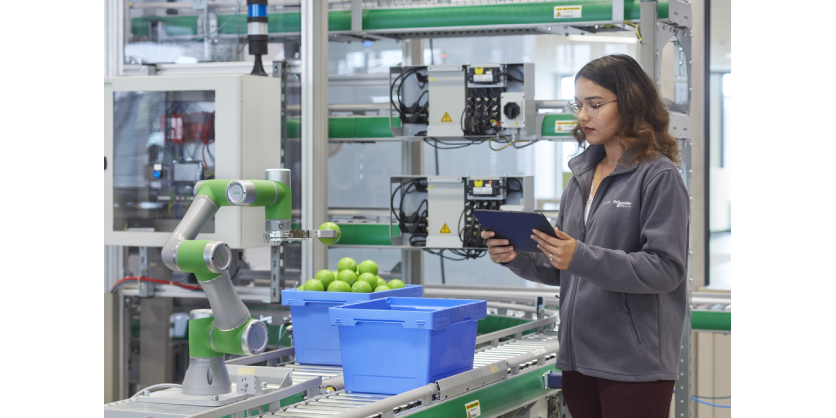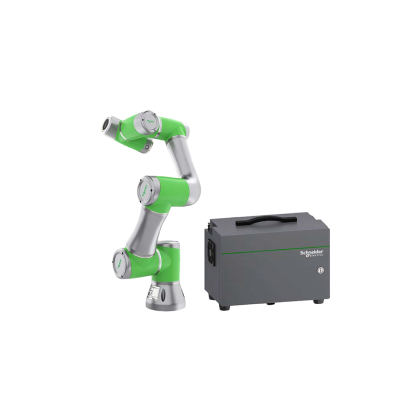Schneider Electric’s New Lexium Cobot in Canada
New robot leverages next-generation automation and advanced industrial robotics technologies for Canadian plants
December 14, 2023

By Krystie Johnston
The Lexium Cobot from Schneider Electric is designed to work safely alongside humans, performing gentle and dynamic movements with one of the smallest footprints on the market.
Schneider Electric has launched its latest technological innovation: the Lexium Cobot. Designed to meet many challenges that industries face today, it can be used to improve plant productivity in a safe and adaptive way thanks to its next-generation automation and advanced industrial robotics technologies. Hugo Lafontaine, Vice President, Industry, Canda at Schneider Electric says, “I like to call it ‘The Helper.’ It has a robotized arm that allows it to do repetitive tasks. It brings efficiency and safety to the work environment, and it is designed to coexist closely with humans. It is state-of-the-art technology that we are bringing to the market.”
The adaptive capabilities of the Lexium Cobot make it extremely useful for several different segments. Manufacturing, automotive, electronics, food and beverage, packaging, pharmaceuticals – any industry that requires repetitive motions – the Lexium Cobot can assist. With many industries facing labour shortages and the need to remain competitive, implementing automation solutions may be a way to overcome these challenges. Yet, with many options available on the market, it is important to understand how the Lexium Cobot can help.
There are many reasons why this cobot is uniquely suited to various industries. Safety may be one of the most important factors to consider, and the Lexium Cobot has been designed with safety in mind.
Because the Lexium Cobot was designed to work closely with humans, safety considerations were paramount. The cobot features rounded joints to reduce potential impacts, torque vectoring to ensure a fast response to resistance, and advanced visualization to prevent collision while in operation. “It has motion control, torque verification, and it leverages 2D and 3D vision to be able to alternate or stop movements while interacting with the environment to ensure safety. By having collision, vision, and force control, the cobot is very, very safe – on top of that, we made it all-round safe. It has rounded joints, so physically, if you touch it or bump into it, it doesn’t hurt you,” says Lafontaine.
Another reason why the Lexium Cobot is a good choice for many customers is because of its size to load capabilities. “It has one of the smallest footprints in the industry. And it has the ability to move between 3kg to 18 kg payloads. It really caters to the light-to-medium load requirements,” says Lafontaine.

In fact, the Lexium Cobot is available in five different models with varying maximum payload capabilities: 3kg, 5kg, 7kg, 12kg, and 18kg maximum payloads are available. Each model, combined with adaptors, can cater to many small to medium enterprises that need to move their products with precision and accuracy in a repeatable and efficient way.
It was important that the Lexium Cobot exemplifies Schneider Electric’s overall vision of integrated automation. To this end, it can communicate to all software platforms, such as EcoStruxure Automation Expert and their twin digitalization models, for example, so it can integrate into the larger ecosystem of automated components, be it other robots, multi carriers, or conveyor belts, regardless of the scale.
It is also important that this new cobot be easy to use for anyone. And that the user does not need to be technically skilled at robotics or software in order to benefit from its capabilities.
“The Lexium Cobot is designed to be very easy to program with graphical, drag and drop functionalities. When the user wants to change the task that is required, they can quickly and independently adjust the function of the cobot, whether that be adjusting the functionality of the cobot moving from one location to another or to leverage the nuances in the day-to-day tasks that it performs,” says Lafontaine.
Schneider Electric’s many design considerations make the Lexium Cobot unique from other cobots on the market today. Safety, small footprint, weight, and being connectable to Schnieder’s offering of software platforms are the main highlights. The Lexium Cobot is available in Canada today. Lafontaine says that there are many orders already, and that people are excited about it.
Customers who are interested in the new Lexium Cobot can reach out for more information. “Schneider Electric Canada is a great place to start. We have a vast number of distributors, and we have a great system of integrators in the market that are being trained right now on this product to be able to support and help their customers. We have an ecosystem in Canada available to help,” says Lafontaine.
“The Lexium Cobot is available in Canada. It is state-of-the-art, and there will be a lot more technologies coming out from Schneider in the next couple of years pertaining to automation, manufacturing, cobots, and multi carriers. We will be a force to contend with in Canada when it comes to robotic technologies.” Hugo Lafontaine, Vice President, Industry, Canda at Schneider Electric.
More Information
Related Story
Schneider Electric Launches Lexium Cobot Technology for Industrial Plants
Schneider Electric, a leader in the digital transformation of energy management and automation, has launched the Lexium Cobot, a collaborative machine featuring next-generation automation and advanced industrial robotics technology. The Lexium Cobot is designed to work closely alongside humans, performing uniquely gentle and diligent movements using dynamic torque and speed monitoring.

